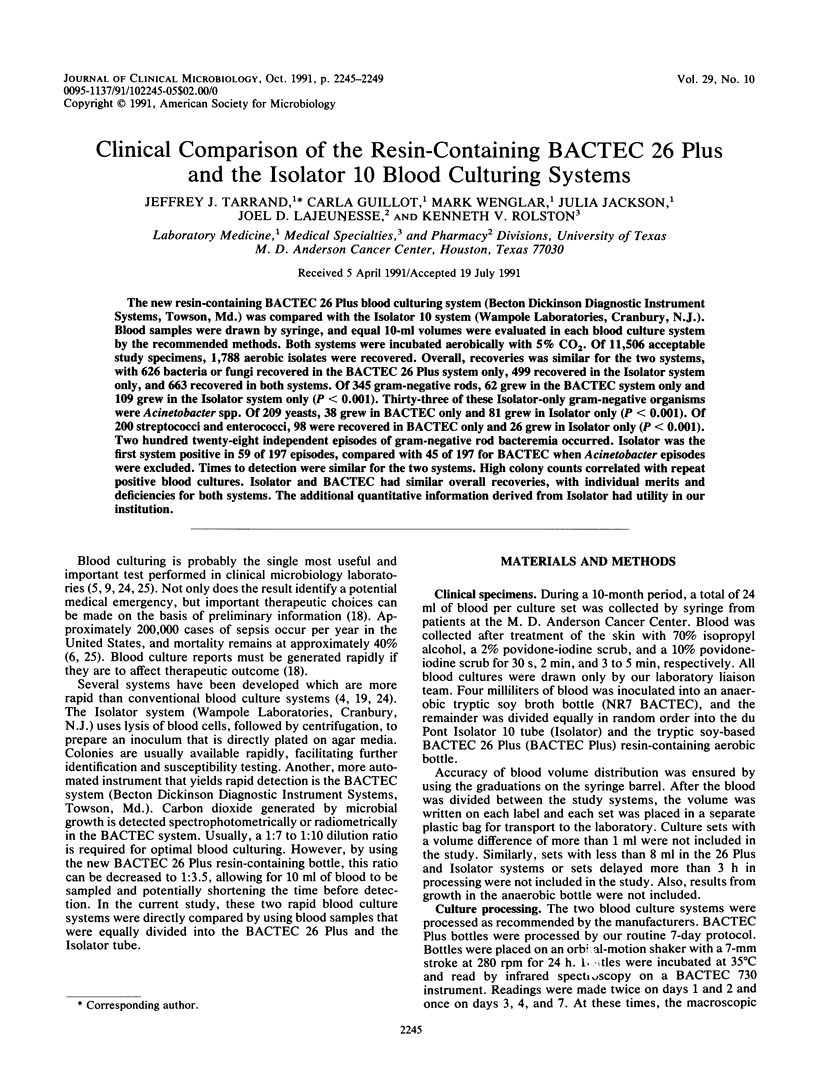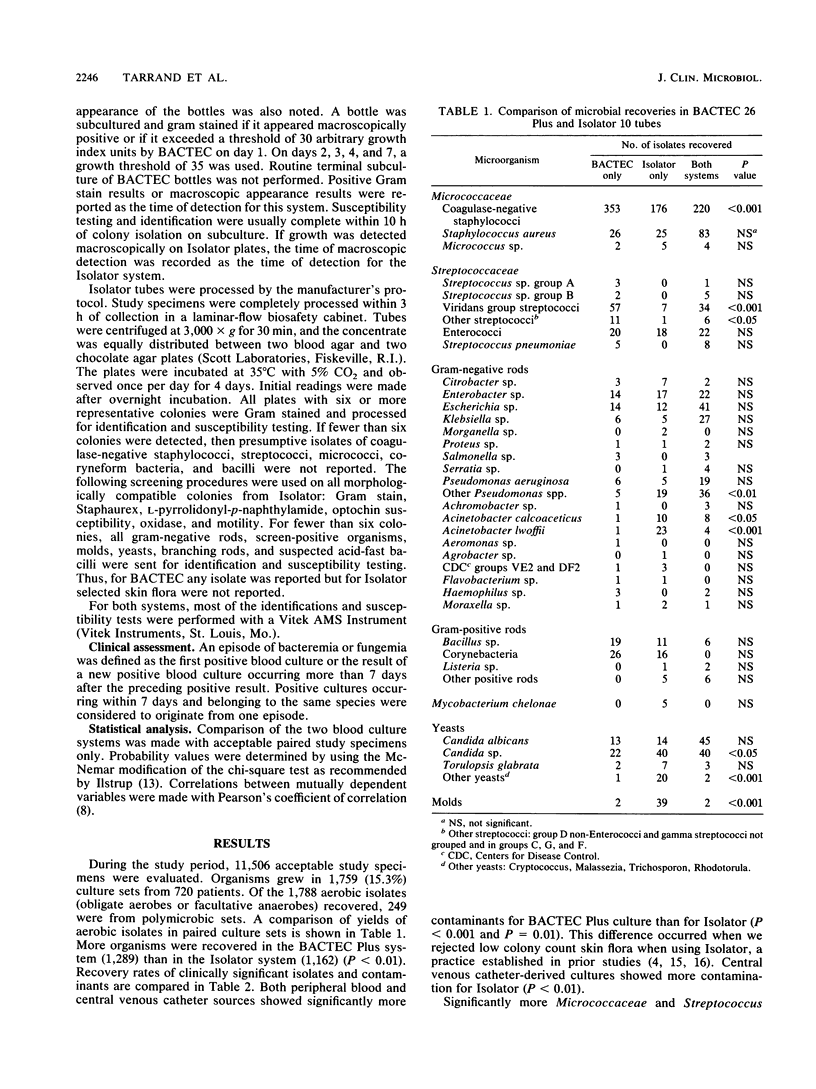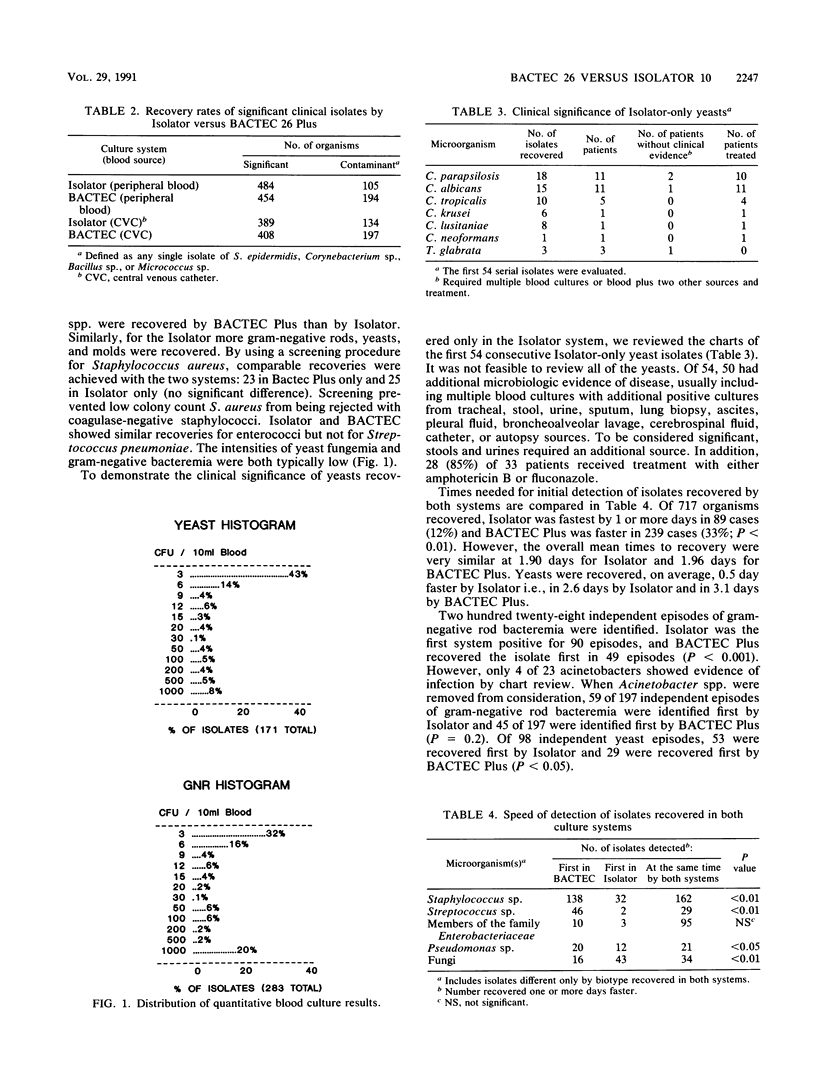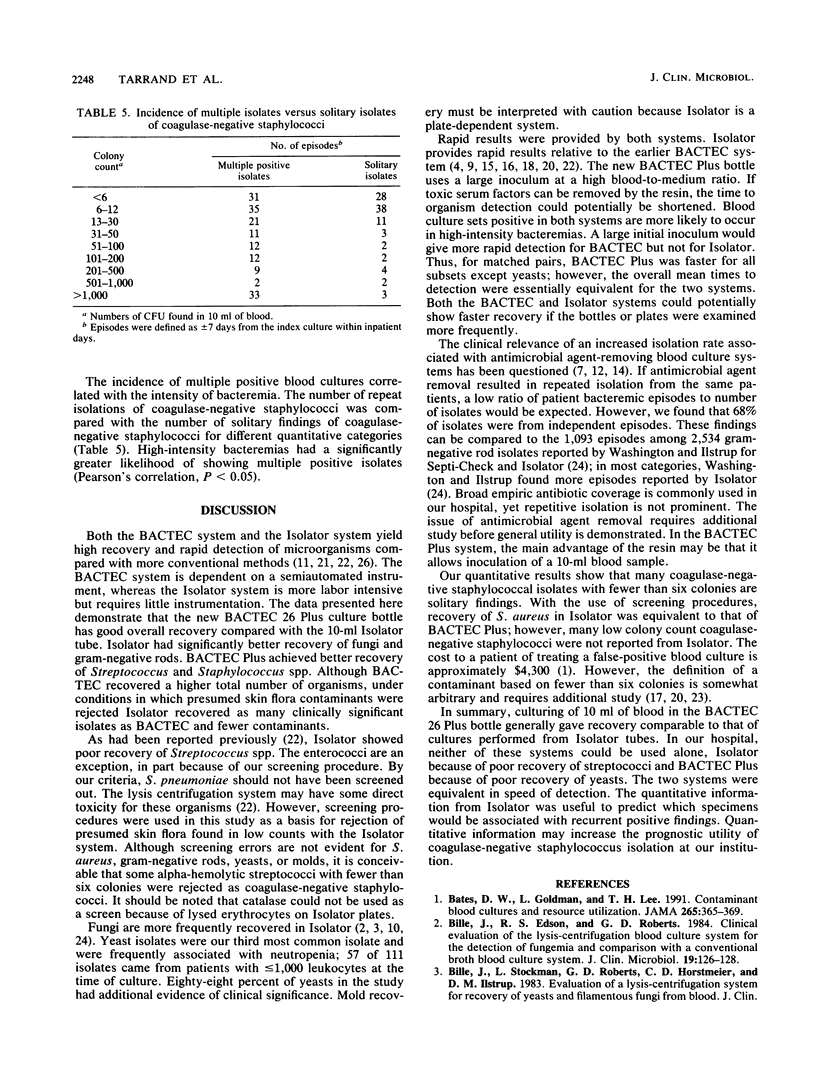Abstract
The new resin-containing BACTEC 26 Plus blood culturing system (Becton Dickinson Diagnostic Instrument Systems, Towson, Md.) was compared with the Isolator 10 system (Wampole Laboratories, Cranbury, N.J.). Blood samples were drawn by syringe, and equal 10-ml volumes were evaluated in each blood culture system by the recommended methods. Both systems were incubated aerobically with 5% CO2. Of 11,506 acceptable study specimens, 1,788 aerobic isolates were recovered. Overall, recoveries was similar for the two systems, with 626 bacteria or fungi recovered in the BACTEC 26 Plus system only, 499 recovered in the Isolator system only, and 663 recovered in both systems. Of 345 gram-negative rods, 62 grew in the BACTEC system only and 109 grew in the Isolator system only (P less than 0.001). Thirty-three of these Isolator-only gram-negative organisms were Acinetobacter spp. Of 209 yeasts, 38 grew in BACTEC only and 81 grew in Isolator only (P less than 0.001). Of 200 streptococci and enterococci, 98 were recovered in BACTEC only and 26 grew in Isolator only (P less than 0.001). Two hundred twenty-eight independent episodes of gram-negative rod bacteremia occurred. Isolator was the first system positive in 59 of 197 episodes, compared with 45 of 197 for BACTEC when Acinetobacter episodes were excluded. Times to detection were similar for the two systems. High colony counts correlated with repeat positive blood cultures. Isolator and BACTEC had similar overall recoveries, with individual merits and deficiencies for both systems. The additional quantitative information derived from Isolator had utility in our institution.
Full text
PDF




Selected References
These references are in PubMed. This may not be the complete list of references from this article.
- Bates D. W., Goldman L., Lee T. H. Contaminant blood cultures and resource utilization. The true consequences of false-positive results. JAMA. 1991 Jan 16;265(3):365–369. [PubMed] [Google Scholar]
- Bille J., Edson R. S., Roberts G. D. Clinical evaluation of the lysis-centrifugation blood culture system for the detection of fungemia and comparison with a conventional biphasic broth blood culture system. J Clin Microbiol. 1984 Feb;19(2):126–128. doi: 10.1128/jcm.19.2.126-128.1984. [DOI] [PMC free article] [PubMed] [Google Scholar]
- Brannon P., Kiehn T. E. Large-scale clinical comparison of the lysis-centrifugation and radiometric systems for blood culture. J Clin Microbiol. 1985 Dec;22(6):951–954. doi: 10.1128/jcm.22.6.951-954.1985. [DOI] [PMC free article] [PubMed] [Google Scholar]
- Bryan C. S. Clinical implications of positive blood cultures. Clin Microbiol Rev. 1989 Oct;2(4):329–353. doi: 10.1128/cmr.2.4.329. [DOI] [PMC free article] [PubMed] [Google Scholar]
- Bryan C. S., Reynolds K. L., Brenner E. R. Analysis of 1,186 episodes of gram-negative bacteremia in non-university hospitals: the effects of antimicrobial therapy. Rev Infect Dis. 1983 Jul-Aug;5(4):629–638. doi: 10.1093/clinids/5.4.629. [DOI] [PubMed] [Google Scholar]
- Callihan D. R., Migneault P. C., Nolte F. S. Clinical and bacteriologic evaluation of BACTEC resin-containing blood culture medium. Am J Clin Pathol. 1984 Oct;82(4):465–469. doi: 10.1093/ajcp/82.4.465. [DOI] [PubMed] [Google Scholar]
- Dorn G. L., Land G. A., Wilson G. E. Improved blood culture technique based on centrifugation: clinical evaluation. J Clin Microbiol. 1979 Mar;9(3):391–396. doi: 10.1128/jcm.9.3.391-396.1979. [DOI] [PMC free article] [PubMed] [Google Scholar]
- Guerra-Romero L., Edson R. S., Cockerill F. R., 3rd, Horstmeier C. D., Roberts G. D. Comparison of Du Pont Isolator and Roche Septi-Chek for detection of fungemia. J Clin Microbiol. 1987 Sep;25(9):1623–1625. doi: 10.1128/jcm.25.9.1623-1625.1987. [DOI] [PMC free article] [PubMed] [Google Scholar]
- Henry N. K., Grewell C. M., McLimans C. A., Washington J. A., 2nd Comparison of the Roche Septi-Chek blood culture bottle with a brain heart infusion biphasic medium bottle and with a tryptic soy broth bottle. J Clin Microbiol. 1984 Mar;19(3):315–317. doi: 10.1128/jcm.19.3.315-317.1984. [DOI] [PMC free article] [PubMed] [Google Scholar]
- Hopfer R. L., Moore D. G., Fainstein V., Watkins S., Wenglar M. Routine use of BACTEC 16B bottles to remove antibacterial and antitumor agents from blood cultures of cancer patients. J Clin Microbiol. 1983 Oct;18(4):759–764. doi: 10.1128/jcm.18.4.759-764.1983. [DOI] [PMC free article] [PubMed] [Google Scholar]
- Ilstrup D. M. Statistical methods in microbiology. Clin Microbiol Rev. 1990 Jul;3(3):219–226. doi: 10.1128/cmr.3.3.219. [DOI] [PMC free article] [PubMed] [Google Scholar]
- Jessamine P. G., Hoban D. J., Forward K. R. Positive Bactec resin cultures do not influence antimicrobial selection. Diagn Microbiol Infect Dis. 1990 Jul-Aug;13(4):281–284. doi: 10.1016/0732-8893(90)90017-p. [DOI] [PubMed] [Google Scholar]
- Kelly M. T., Roberts F. J., Henry D., Geere I., Smith J. A. Clinical comparison of isolator and BACTEC 660 resin media for blood culture. J Clin Microbiol. 1990 Sep;28(9):1925–1927. doi: 10.1128/jcm.28.9.1925-1927.1990. [DOI] [PMC free article] [PubMed] [Google Scholar]
- Kiehn T. E., Wong B., Edwards F. F., Armstrong D. Comparative recovery of bacteria and yeasts from lysis-centrifugation and a conventional blood culture system. J Clin Microbiol. 1983 Aug;18(2):300–304. doi: 10.1128/jcm.18.2.300-304.1983. [DOI] [PMC free article] [PubMed] [Google Scholar]
- Martin M. A., Pfaller M. A., Wenzel R. P. Coagulase-negative staphylococcal bacteremia. Mortality and hospital stay. Ann Intern Med. 1989 Jan 1;110(1):9–16. doi: 10.7326/0003-4819-110-1-9. [DOI] [PubMed] [Google Scholar]
- Murray P. R., Niles A. C., Heeren R. L., Curren M. M., James L. E., Hoppe-Bauer J. E. Comparative evaluation of the oxoid signal and Roche Septi-Chek blood culture systems. J Clin Microbiol. 1988 Dec;26(12):2526–2530. doi: 10.1128/jcm.26.12.2526-2530.1988. [DOI] [PMC free article] [PubMed] [Google Scholar]
- Phillips S. E., Bradley J. S. Bacteremia detected by lysis direct plating in a neonatal intensive care unit. J Clin Microbiol. 1990 Jan;28(1):1–4. doi: 10.1128/jcm.28.1.1-4.1990. [DOI] [PMC free article] [PubMed] [Google Scholar]
- Reimer L. G., McDaniel J. D., Mirrett S., Reller L. B., Wang W. L. Controlled evaluation of supplemented peptone and Bactec blood culture broths for the detection of bacteremia and fungemia. J Clin Microbiol. 1985 Apr;21(4):531–534. doi: 10.1128/jcm.21.4.531-534.1985. [DOI] [PMC free article] [PubMed] [Google Scholar]
- Thomson R. B., Jr, Vanzo S. J., Henry N. K., Guenther K. L., Washington J. A., 2nd Contamination of cultures processed with the isolator lysis-centrifugation blood culture tube. J Clin Microbiol. 1984 Feb;19(2):97–99. doi: 10.1128/jcm.19.2.97-99.1984. [DOI] [PMC free article] [PubMed] [Google Scholar]
- Washington J. A., 2nd, Ilstrup D. M. Blood cultures: issues and controversies. Rev Infect Dis. 1986 Sep-Oct;8(5):792–802. doi: 10.1093/clinids/8.5.792. [DOI] [PubMed] [Google Scholar]
- Weinstein M. P., Murphy J. R., Reller L. B., Lichtenstein K. A. The clinical significance of positive blood cultures: a comprehensive analysis of 500 episodes of bacteremia and fungemia in adults. II. Clinical observations, with special reference to factors influencing prognosis. Rev Infect Dis. 1983 Jan-Feb;5(1):54–70. doi: 10.1093/clinids/5.1.54. [DOI] [PubMed] [Google Scholar]
- Weinstein M. P., Reller L. B., Mirrett S., Stratton C. W., Reimer L. G., Wang W. L. Controlled evaluation of the agar-slide and radiometric blood culture systems for the detection of bacteremia and fungemia. J Clin Microbiol. 1986 Feb;23(2):221–225. doi: 10.1128/jcm.23.2.221-225.1986. [DOI] [PMC free article] [PubMed] [Google Scholar]


